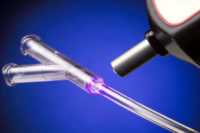Researchers at Stanford University have developed a way to use silicon nanowires to improve the rechargeable battery technology used in cordless tools and other devices. The new technology produces 10 times the amount of electricity of existing lithium-ion batteries.
Nanotechnology could make today’s lithium-ion batteries a thing of the past. Researchers at Stanford University (Palo Alto, CA) have developed a way to use silicon nanowires to improve the rechargeable battery technology commonly used in cordless tools and other devices. The new technology produces 10 times the amount of electricity of existing lithium-ion batteries.
Traditionally, the electrical storage capacity of a lithium-ion battery is limited by how much lithium can be held in the battery’s anode, which is typically made of carbon. Silicon has a much higher capacity than carbon, but also has a drawback.
Silicon placed in a battery swells as it absorbs positively charged lithium atoms during charging, then shrinks during use as the lithium is drawn out of the silicon. This expand-shrink cycle typically causes the silicon (often in the form of particles or a thin film) to pulverize, degrading the performance of the battery.
The Stanford battery gets around this problem by using nanotechnology. The lithium is stored in a forest of tiny silicon nanowires, each with a diameter one-thousandth the thickness of a sheet of paper. The nanowires inflate four times their normal size as they soak up lithium. But, unlike other silicon shapes, they do not fracture.
“It’s not a small improvement,” claims Yi Cui, an assistant professor of materials science and engineering. “It’s a revolutionary development. Given the mature infrastructure behind silicon, this new technology can be pushed to real life quickly.
“Manufacturing the nanowire batteries would require one or two different steps, but the process can certainly be scaled up,” adds Cui. “It’s a well understood process.”
The greatly expanded storage capacity could make lithium-ion batteries attractive to electric car manufacturers. According to Cui, they could also be used in homes or offices to store electricity generated by rooftop solar panels.
Research on silicon in batteries began 3 decades ago. “[But], people gave up on it because the capacity wasn’t high enough and the cycle life wasn’t good enough,” says Cui. “It was just because of the shape they were using. It was just too big, and they couldn’t undergo the volume changes.”
Then, along came silicon nanowires. For their experiments, Cui and his colleagues grew the nanowires on a stainless steel substrate, which provided an excellent electrical connection.
Nanotechnology Transforms Lithium-ion Batteries
Looking for a reprint of this article?
From high-res PDFs to custom plaques, order your copy today!




